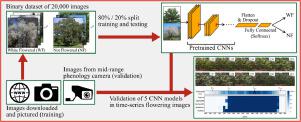Ecological Modelling ( IF 2.6 ) Pub Date : 2020-12-26 , DOI: 10.1016/j.ecolmodel.2020.109419 Tae Kyung Kim , Sukyung Kim , Myoungsoo Won , Jong-Hwan Lim , Sukhee Yoon , Keunchang Jang , Kye-Han Lee , Yeong Dae Park , Hyun Seok Kim

|
The responses of plants to climate change are typically reflected in the changes in leaf and flowering phenology. By exploiting the strength and simplicity of repeated digital photography and color indices, a majority of the phenological studies have been successful at investigating leaf phenology, while flowering phenology is rarely studied using the automatic capture and analysis of repeated photography. In this study, we trained and tested 5 different pretrained Convolutional Neural Network (CNN) algorithms to detect flowering events from images of white colored flowering trees and analyzed the possible factors that can affect the performance of the models. We collected images from the web and processed the images into a binary classification dataset in which a positive label indicated a tree in bloom. We also installed time-lapse cameras and captured images to validate the performances of the models in the real-world. Regarding the CNN architectures, the VGG16, ResNet50, ResNet101, MobileNet, and NASNet models were adopted, and the model weights were pretrained using the ImageNet-1000 dataset. After 20 epochs of training with 16,005 images, all of the models were successfully trained, reaching over 98% test accuracy, and 4 models reached over 99% test accuracy. All the models also showed accurate and stable performances in detecting flowering in time-series datasets with a minor inconstancy at the beginning of the flowering stages. Overall, the NASNet model showed the best performance in both the test dataset and the time-series datasets. A detailed analysis of the performance revealed that the models were especially prone to misclassify images with small relative flowering areas and were affected by the number of samples in the training dataset. We concluded that the preprocessing of the images and the size of the training dataset are essential for the high performance of the models compared to the architecture of the individual models. Furthermore, in addition to the need for a larger dataset, the proper resolution is required to successfully detect flowering from repeated photography, and most current phenological networks do not meet this condition. We suggest that mid-range photography combined with CNN algorithms can be a legitimate approach to properly accumulate and automatically process the data for studying flowering phenology.
中文翻译:

利用机器学习检测中部开花
植物对气候变化的反应通常反映在叶片和开花物候的变化中。通过利用重复数码摄影和色彩指数的强度和简便性,大多数物候研究已成功地研究了叶片的物候,而很少使用自动拍摄和重复摄影分析来研究开花物候。在这项研究中,我们训练和测试了5种不同的预训练卷积神经网络(CNN)算法,以从白色开花树木的图像中检测开花事件,并分析了可能影响模型性能的因素。我们从网络上收集了图像并将其处理成一个二进制分类数据集,其中一个正标签表示一棵开花的树。我们还安装了延时摄影机和捕获的图像,以验证模型在现实世界中的性能。对于CNN架构,采用了VGG16,ResNet50,ResNet101,MobileNet和NASNet模型,并使用ImageNet-1000数据集对模型权重进行了预训练。经过20个时期的16,005张图像训练后,所有模型均成功训练,达到了98%以上的测试准确度,有4个模型达到了99%以上的测试准确度。所有模型还显示了在开花阶段开始时具有较小不一致的时间序列数据集中检测开花的准确和稳定的性能。总体而言,NASNet模型在测试数据集和时间序列数据集中均显示出最佳性能。对性能的详细分析显示,这些模型特别容易对相对开花面积较小的图像进行错误分类,并且受训练数据集中样本数量的影响。我们得出的结论是,与单个模型的体系结构相比,图像的预处理和训练数据集的大小对于模型的高性能至关重要。此外,除了需要更大的数据集外,还需要适当的分辨率才能成功地从重复的摄影中检测出花朵,并且大多数当前的物候网络均不满足此条件。我们建议将中距离摄影与CNN算法结合使用,可以是合理积累和自动处理用于研究开花物候的数据的合法方法。











































 京公网安备 11010802027423号
京公网安备 11010802027423号